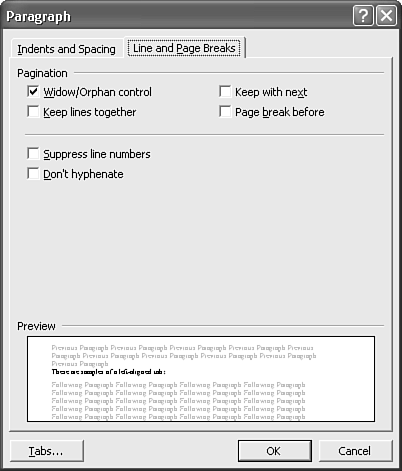Controlling How Paragraphs Break Between Pages
In documents, a widow is the last line of a paragraph that appears by itself at the top of a page. An orphan is the first line of a paragraph left to fend for itself at the bottom of a page. To readers, a widow or an orphan can easily be confused with a subhead. For years, typographers and graphic designers have done everything possible to eliminate widows and orphans.
You rarely see a widow or an orphan in a Word document, because Word includes a feature called Widow/Orphan control. If Word encounters a paragraph that will be split at the bottom of the page, separating one line from all the rest, Word automatically makes sure that the entire paragraph prints together. For example, it moves the potentially orphaned line to the top of the next page with the rest of its "family."
Widow/Orphan Control is one of four Pagination settings Word provides in the Line and Page Breaks tab of the Paragraph dialog box (see Figure 4.17). You can use these settings to make sure that your page breaks don't unnecessarily interrupt or inconvenience your readers.
Figure 4.17. The Line and Page Breaks tab controls pagination and whether line numbers or hyphenation will be applied to selected text.

Although Widow/Orphan Control is turned on by default, the other three settings are turned off unless you check them.
As with the other paragraph formatting elements you've seen, you can apply Pagination controls to a specific paragraph or paragraphs you select, or you can select the entire document and apply them universally. You can also include Pagination controls in styles so that they can be used automatically throughout your document.
The various settings available are as listed here:
Keep Lines Together. Whereas Widow/Orphan Control prevents page breaks that leave single lines by themselves, Keep Lines Together prevents all page breaks that interrupt paragraphs. When a page break is needed, Word simply jumps the entire paragraph to the next page. Keep Lines Together can be especially handy in tables, where it prevents a few lines of a table (or, worse, parts of a single table row) from jumping onto the next page by themselves.
Keep with Next. Sometimes you have two paragraphs that must stay together. For example, you might have a figure caption that needs to stay with an accompanying table. Or you might have space on a contract for signatures that need to be on the same page as other contract clauses.
Page Break Before. This option forces a manual page break before a paragraph. You might use this feature if you expect a paragraph to create pagination problems and you're not sure that Word will handle them properly.
TIP
If you have a document that must have one paragraph on each page, use Page Break Before rather than manual page breaks. It's quicker, easier to keep consistent, and easier to change if necessary.
NOTE
Pagination controls don't apply to Web pages, which by definition consist of only one page apiece.








